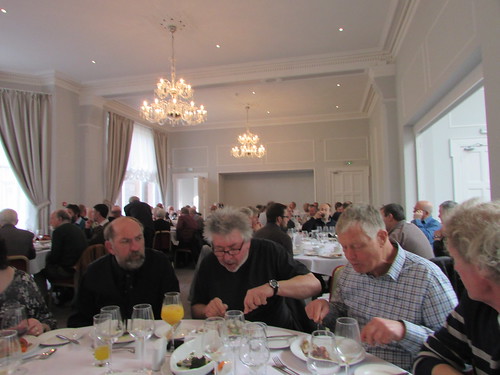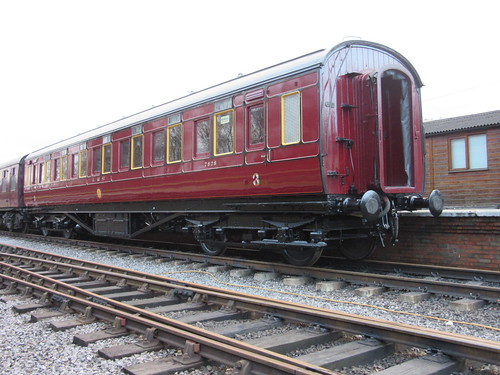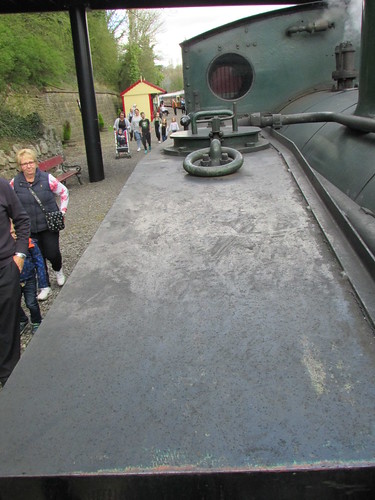Peak Rail Working Volunteers Lunch
My first trip to the Matlock area in 2017 was on Saturday, 18th February when I didn't get beyond Matlock Bath. I was attending the Peak Rail Working Volunteers Lunch which was held at the elegant Matlock Bath Hotel. As this engagement didn't involve the usual pre-dawn start needed when I'm rostered for the footplate, I travelled by train. There were existing photograph albums covering part of the route I took, from Wolverhampton to Birmingham New Street, then on to Derby. These albums are West Midland Railways and Derby - Birmingham. The last leg of my journey was by East Midland Trains single unit DMU to Matlock Bath, one station before the last stop at Matlock. I've added a new album Derby - Matlock to cover this area.

Class 153 355 on arrival at Matlock Bath.
The effort involved by working volunteers in running an operation like Peak Rail could be judged from the crowded dining room. In addition to the convivial lunch, Peak Rail Management took the opportunity to update members on some of the developments in hand.

Peak Rail Volunteers' Lunch: 18-Feb-2017
Events of Sunday, 26th March 2017
Saturday and Sunday services re-started in March, with a timetable of four top-and-tailed services between Rowsley and Matlock Town.
My first driving turn of the year was on Sunday, 26th March. This time, it was an early start, made worse by the clocks going forward an hour on Saturday night. So my alarm had to be set for 3.0 a.m. when I retired which, of course, would be 4.0 a.m. when I got up on Sunday morning.
The motive power was 'Jennifer', an outside-cylinder six-coupled Hudswell Clarke side tank, built the same year that I was born. With Mike S. as Fireman and Jacob as cleaner, we were ready to come 'off shed' at 8.30 a.m. ready for two one-hour Driving Experience Courses before taking the first service train at eleven o'clock. The combination of outside cylinders and the characteristics of the drawgear had been found to cause oscillations at some speeds so an instruction was in place that 'Jennifer' should not exceed 15 miles per hour.

Locomotive 'Jennifer' at Matlock Town.
I used the first trip to experiment with methods of driving to try to minimise the 'surging' effect, particularly since the 'Palatine' Restaurant Cars were being 'laid-up' by waiting staff for the diners who would board before the second round trip to enjoy the Mothering Sunday Lunch. This season, the beautifully-restored L.M.S. coach 7828 forms the main dining coach of the 2-car dining set.

Restored coach 7828 at Rowsley.
'Jennifer' proved a strong engine and a free-steamer and we completed the day without additional difficulties.
Events of Sunday, 2nd April 2017
Just a week later, I was back again, this time with Dave P. as fireman but with no Cleaner, starting the day with a two-hour driving experience before 'hooking onto' our train. Normally, it's good practice to tighten up the screw coupling between engine and train leaving two turns of thread visible on either side but, in order to provide as much buffer compression as possible to limit the tendency to 'surge', we tightened the screw fully and it seemed to help.
Now we were into April, the timetable called for five top-and-tailed services between Rowsley and Matlock Town, which we completed without problems.

'Jennifer' at Matlock Town, showing the 'bevelled' front of the side tank to assist the driver's forward visibility.
Events of Wednesday, 6th April 2017
Three days later I was back yet again because April also introduced a service on Wednesdays. Keiron was firing with John M. as our Cleaner. At 08:45 we started the first of two 1-hour Driving Experience Courses, leaving us very little time before taking the first service train at 11:00. During the day, further experiments were carried out on the coupling between locomotive and train. I was sure that the use of the engine coupling onto the coach drawhook would be tighter than the other way round (coach coupling onto engine drawhook), and so it proved. But we also tried the Emergency Coupling which is kept in the Guard's compartment. These have a D-hook on both sides of the screw and are used to connect the two drawhooks, as the name suggests, in emergency. However, this offered no improvement so we reverted to the engine coupling onto the coach drawhook with the screw fully tightened. The weather was warm all day and we were gratifyingly busy for a mid-week steaming. Incidentally, there's a short description of the business of hooking a locomotive onto a passenger train in the post On the Footplate (Part 2). At the end of an enjoyable day, Keiron coaled the engine using the bucket loading shovel and 'Jennifer' was stabled in the shed. The method of disposal varies from railway to railway and from locomotive to locomotive but an idea of what's involved can be gained from the post MIC - Disposal.
My Pictures
Where necessary, clicking on an image above will display an 'uncropped' view or, alternately, pictures from may be selected, viewed or downloaded, in various sizes, from the albums listed:-
West Midland Railways.
Derby - Birmingham.
Derby - Matlock.
Peak Rail 2017.
'Jennifer'.
Restored coach 7828.
